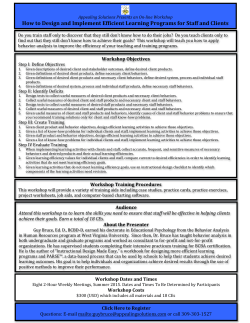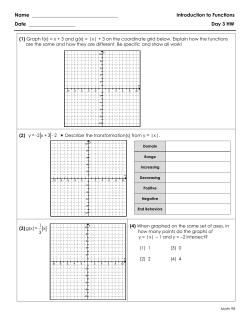
Study links learning design to changes in
lessons from research JOELLEN KILLION Study links learning design to changes in knowledge, beliefs, and behaviors WHAT THE STUDY SAYS I n this study of 16 teachers in two primary schools in the Netherlands, researchers built on findings from previous studies to demonstrate that a thoughtfully designed professional development program can be “effective and sustainable, if certain conditions are met” (p. 772) in changing teachers’ knowledge, beliefs, perceived problems, and classroom practices. At a glance Professional development to improve teachers’ practice in giving feedback to students during active learning is difficult. This small-scale, pre- and post-test study of teachers of 9- to 12-year-olds demonstrates that professional development thoughtfully designed applying research-based features influences teachers’ knowledge, beliefs, and behaviors. THE STUDY Van den Bergh, L., Ros, A., & Beijaard, D. (2014). Improving teacher feedback during active learning: Effects of a professional development program. American Educational Research Journal, 51(4), 772-809. Study description Linda Van den Bergh, Anje Ros, and Douwe Beijaard designed a teacher professional development program to improve teachers’ knowledge, beliefs, perceived problems, and classroom behaviors related to student feedback during active learning. Questions The study focused on the shortand long-term effects of a professional development program aimed at improving teacher feedback during active learning on: • Primary school teachers’ beliefs • Joellen Killion (joellen.killion@ learningforward.org) is senior advisor to Learning Forward. In each issue of JSD, Killion explores a recent research study to help practitioners understand the impact of particular professional learning practices on student outcomes. 58 JSD | www.learningforward.org regarding feedback during active learning; • The problems primary school teachers perceive regarding feedback during active learning; and • Primary school teachers’ feedback behaviors in the context of active learning. Methodology The study included 16 teachers who taught 9- to 12-year-olds in two schools randomly selected from 13 schools that had previously participated in studies of active learning with a teacher training institute in southeastern Netherlands. All upper-grades primary teachers, nine in one school and seven in the other, participated as a group. The schools were from a pool of 23 that indicated they practiced active learning. Active learning is defined as “any instructional method that requires students to do meaningful learning activities and to think about what they are doing” (p. 773). The professional development program integrated a number of key features of effective professional development drawn from the literature, including: • Sustainable and intensive; • Collective participation; • Clear goals that are communicated; • Solving real-world problems with working examples; • Modeling effective behaviors by trainer; • Authentic and integrated activities; • Plenty of opportunities for active learning; • Building on teachers’ existing knowledge as a foundation for new knowledge; • Demonstration and application of new knowledge; and • Reflection on action. Teachers participated for four months. In each month, a four-step April 2015 | Vol. 36 No. 2 WHAT THIS MEANS FOR PRACTITIONERS R esearchers provided evidence that well-designed professional development can result in changes in teachers’ beliefs, perceived problems, and behaviors when it builds on teachers’ existing knowledge, perceptions, and practices and when it integrates characteristics of effective professional learning. The study confirms that deep change in teacher beliefs, perceived problems, and behaviors requires sustained support over time. Researchers conclude that it is possible to enhance teachers’ classroom behavior in lasting ways by implementing a carefully designed professional development program (p. 804). By improving teacher behavior associated with student academic success, such as feedback and active learning, professional development has the potential to improve student success. cycle was repeated. Step one was an informational meeting that focused on theory about feedback during active learning and included videotaped examples. Each month’s information session focused on a different aspect of feedback. The first month focused on giving feedback that relates to student performance or understanding related to specific learning goals. The second month focused on confirming, critical, and constructive feedback. The third month focused on balancing directive and facilitative feedback. The last month focused on feedback on student metacognition and social learning. In the second step of the cycle, researchers videotaped each participant leading a 20-minute active learning lesson in which teachers applied their new learning. Third, teachers analyzed their own videotape to select four clips in which they exhibited “optimal and nonoptimal feedback behavior” (p. 785) related to that month’s goal. Last, teachers met with colleagues to share and discuss their video clips and received tailored feedback from the trainer and their colleagues. Teachers used logbooks to note plans for applying feedback behaviors and reflecting on their behaviors. Analysis Researchers used three measures to study the effects of the professional development program: videotapes of April 2015 | Vol. 36 No. 2 each participant, a beliefs instrument, and a perceived problems instrument, all collected before the start of the professional learning, immediately after it, and seven months after it ended. Teacher-student interactions from the videotapes served as the unit of analysis. Researchers coded and aggregated the interactions to the teacher level to permit analysis of focus and frequency of teacher feedback behavior and comparison between teacher pretest behavior and each of the subsequent post-tests. The teacher beliefs instrument yielded 26 concepts that represented different beliefs that were coded as not mentioned or mentioned. New beliefs that emerged after the professional development program were added. Researchers analyzed differences in the proportion of teachers who mentioned each belief between the pretest and each of the subsequent post-tests. The teacher perceived problems instrument yielded mean scores for the pre-, post-, and delayed post-test administrations. Researchers compared pretest means to each of the post-test means. Results The study yielded findings related to each research question. At the first post-test following the professional development program, 63% of teachers noted beliefs related to learning goals, including focusing feedback on social learning, giving goal-directed feedback, and giving confirmative, critical, and constructive feedback. In addition, 50% of teachers mentioned that feedback should be constructive, and 44% noted that feedback can focus on student metacognition. During the delayed post-test, similar changes in teachers mentioning of beliefs occurred. Other beliefs not addressed in the professional development program decreased over time. Researchers conclude, “These results indicate a change in the beliefs of teachers regarding these important facets of feedback during active learning” (p. 793). Although teacher beliefs changed, not all of their behaviors changed at the same level. The professional development program did not have a significant effect on teachers’ perceived problems related to their feedback behavior during active learning, although several problems identified in the pretest diminished following the program. The professional development program had varied effects on teacher feedback behavior during active learning. Overall, the focus of teacher feedback did not change. However, there was a significant effect on the focus related to metacognition immediately after the program that was not sustained to the delayed post-test. Statistically, more teacher feedback was related to the learning goal after the www.learningforward.org | JSD 59 lessons from research JOELLEN KILLION professional development program and sustained through the delayed post-test. In terms of the nature of teachers’ feedback, they gave significantly more confirming feedback and significantly less neutral feedback during active learning during the first and second post-tests than in the pretest. Researchers conducted a deeper analysis and found that the professional development program changed the way teachers gave feedback. They formed three subgroups of teachers: high, average, and low, based on teachers’ pretest use of directive feedback behaviors. After the program, teachers in the low subgroup gave statistically more directive feedback in the second post-test. A separate analysis revealed that teachers in the medium and high subgroups gave statistically less directive and more facilitative feedback in at least the first post-test situation. The study confirms the relationship among teachers’ behaviors, their perceived problems, and their beliefs. In addition, it explores how professional development design influences the outcomes achieved. By examining teachers’ beliefs, perceived problems, and behaviors before the professional development program, researchers were able to build on their foundation and integrate them into professional development that motivated them and addressed their particular context. The use of video embedded within teachers’ professional practice enhanced the professional development program with examples drawn from actual classroom experiences. Limitations The researchers cite a number of limitations of this study, including: • The limited number of participants; • The small number of schools; • The short-term duration of the professional development program; and • The amount of time for implementation of the two latter foci of the professional development program cycle. Overall, the duration of the professional development program was brief considering the degree of expected change in practice. Another major limitation was the pretest post-test design without a control group. In addition, the professional development program was the same for all teachers without attention to the various ways teachers learn. By examining only mean differences among the 16 participants, the study yielded no information about variations in teachers’ learning. These limitations suggest the need for further study of the professional development program for changing teachers’ beliefs, perceived problems, and feedback behaviors during active learning. ■ Do you know how your system aligns to the Standards for Professional Learning? With Learning Forward’s Standards Assessment Inventory 2 (SAI2), you can quickly and easily assess the quality of your system’s professional learning. SAI2 is ideal for state, provincial, regional, and local school systems. Learn more about the role of the standards within your educator effectiveness and student achievement efforts. Visit www.learningforward.org/SAI or call 202-630-1489. www.learningforward.org / 800-727-7288 60 JSD | www.learningforward.org April 2015 | Vol. 36 No. 2
© Copyright 2025









